When mentioning Binh Dinh tourism, in addition to mentioning the beautiful beaches, majestic mountain scenery, and famous delicious specialties, we must also mention the popularity of sacred temples with unique architecture. Let’s take a look at the most famous pagoda in Binh Dinh today with Vietnam Reviewer.
Table of Contents
Top 7 most famous Pagoda in Binh Dinh
Thien Hung Pagoda
Thien Hung Pagoda is located in An Nhon town, only about 20 km east of Quy Nhon city center. This temple attracts tourists and Buddhists not only because of its tourism factor but also because of its sacred spiritual meaning. People say that this is the place where the Jade Relics of Buddha Shakyamuni are kept and that wherever the Jade Relics are located, that place will be blessed by the Buddha. Every year, the pagoda welcomes many tourists and heads of state to visit, partly thanks to the reputation of the abbot, Venerable Thich Dong Ngo, who is extremely knowledgeable about feng shui as well as active in propagating the Dharma. Thien Hung Pagoda is not as magnificent and brilliant as many other famous pagodas.
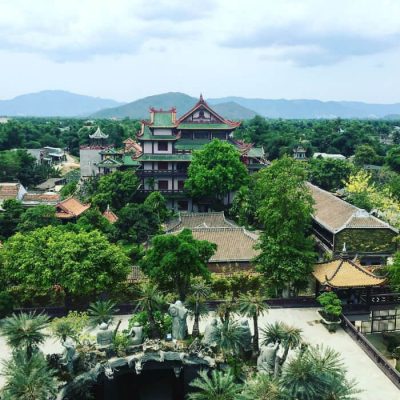
However, it makes visitors extremely fascinated as soon as they set foot on the temple grounds. If you are asked what is the most impressive thing about Thien Hung Pagoda, please answer that it is the houses built with curved tiled roofs like ancient royal palaces, interspersed with ornamental pots with beautiful, unique shapes that are neatly trimmed. neat and green all year round. The campus is decorated with many ornamental plants, giving people a fresh and pleasant feeling. The cool green color makes this peaceful place even more peaceful.
Constructions built entirely according to Eastern architecture easily create a feeling of closeness, familiarity, softness, and antiquity. Through the camera lens of tourists, Thien Hung Pagoda in Binh Dinh is not only a religious-cultural building but also becomes an artistic picture sketched through the delicate brushstrokes of a talented artist. Stepping into this place is like getting lost on the set of an elaborately choreographed epic historical film.
Standing out among the temple grounds is the towering 12-storey Bell Tower poking into the blue sky. Besides, rockery, statues of Buddhas and clear sounds coming from the temple bell are “specialties” that are not difficult to find at Thien Hung Pagoda. If you are a follower of Buddhism or simply a person who is passionate about the art of beauty, don’t miss the opportunity to visit Thien Hung Pagoda in Binh Dinh!
- Address: Nhon Hung Ward, An Nhon Town, Binh Dinh Province
Ong Nui Pagoda
Ong Nui Pagoda, also known as Linh Phong Son Tu, is located on Chop Vung Peak, Phu Cat district, about 30 km from Quy Nhon City. According to old histories, the pagoda was formed in 1702 under the reign of Lord Nguyen Phuc Chu. At this time, a monk with the customary name Le Ban came to the cave east of Ba Mountain to meditate. Here he built a small temple named Dung Tuyen pagoda. Zen Master Le Ban is a pioneer in Buddhist teachings, practicing all year round in the mountains, wearing clothes made of tree bark, and specializing in picking medicine to cure diseases and save people. People in the area very respectfully call him Mr. Nui. On the northern slope of the mountain, there are still remains of a large cave deep into the mountain, which people today call To Cave. That is where Mr. Nui practiced before. In 1733, Lord Nguyen, admiring the monk’s virtue, gave him the title Tinh Giac Thien Tri, a great Zen master, and rebuilt the Dung Tuyen temple into a larger temple named Linh Phong Zen.
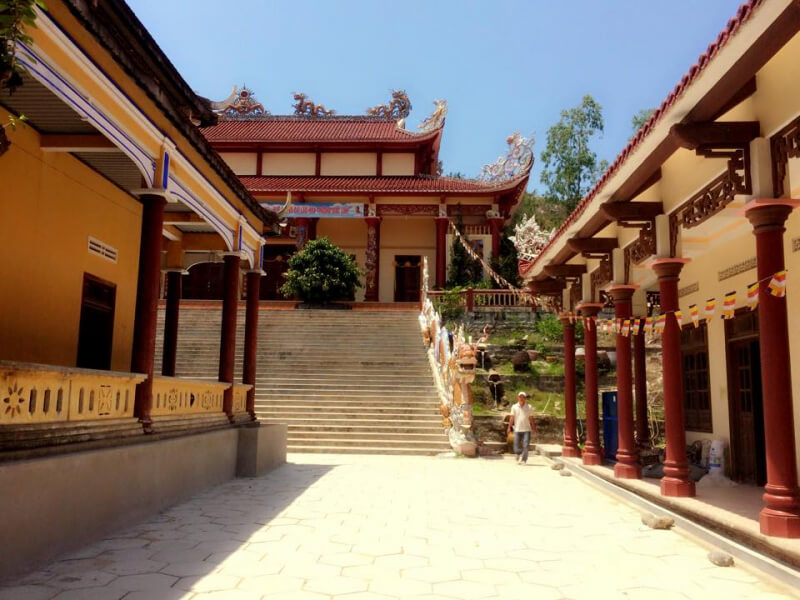
To reach the gate of Linh Phong Pagoda, from the foot of the mountain, visitors walk on a smooth and airy sandy dirt road. After that, you have to walk through hundreds of stone steps on winding paths like a dragon flying from the foot of Ba mountain, with a height of more than 100m. From here, you can see the majestic Ba mountain range, the peaceful countryside at the foot of the mountain, and in the distance is the panorama of Phuong Mai peninsula, Nhon Hoi economic zone next to Thi Nai lagoon. From the front of the main hall of the pagoda, go west across a small bridge that will lead to the Tower tombs and to the To cave located on the mountain behind the pagoda. Legend has it that To Cave is where Mr. Nui once lived and chanted Buddhist scriptures. Up to now, the cave still retains its wild appearance with cliffs inside and landscape outside. Ong Nui Pagoda is a National Historical – Cultural relic, up to now it has been inherited by 12 generations. Every year, the Ong Nui Pagoda festival takes place on the 24th and 25th of the first lunar month – the death anniversary of To Vien Minh of the pagoda. On this occasion, thousands of people and tourists make pilgrimages to visit Buddha, admire the scenery, and go to To cave to offer incense to admire the merits of Ong Nui.
- Address: Road TL 639, hamlet, Phuong Phi, Phu Cat, Binh Dinh
Thap Thap Pagoda
Amitabha Thap Thap Pagoda is over 300 years old and is an attractive place that tourists should not miss when exploring the land of Binh Dinh. Located in Nhon Thanh ward, An Nhon town, Binh Dinh province, Thap Thap Di Da Pagoda, or Thap Thap Pagoda is one of the most famous pagodas in the Central region. The pagoda is located on a hill named Long Bich, north of the Do Ban citadel of the ancient Cham people. The name “Thap Thap” originates from the fact that on this hill there were once 10 Cham towers, which later collapsed and gradually lost their traces. The pagoda was formed in 1683, when Zen master Nguyen Thieu, a monk originally from Guangdong province, China, used bricks and stones from 10 fallen towers to build the pagoda. The pagoda has undergone many renovations, and its current appearance was shaped in the early 20th century.
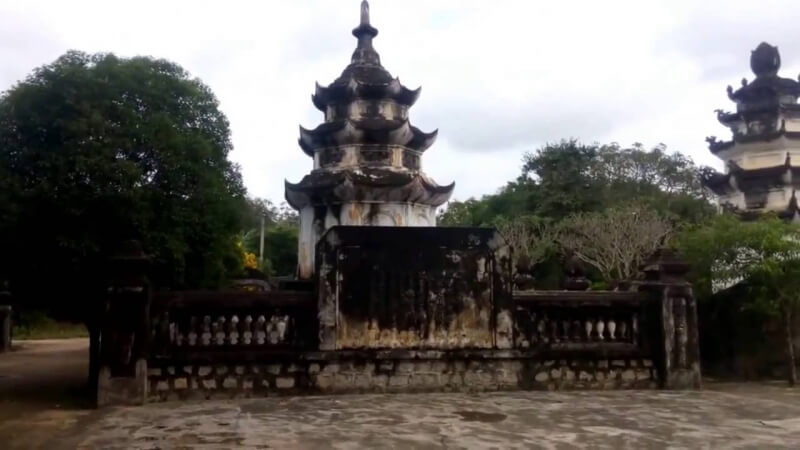
In front of the temple gate is a lotus pond about 500 square meters wide. Every summer, lotus flowers bloom flagrantly in the area. The temple gate has two tall square pillars, on top of which are placed two lion statues sitting majestically. Behind the gate is a screen placed on a kneeling pedestal. The front side has lost its motifs due to time, the back side is embossed with dragon and horse symbols. The pagoda has Khau-shaped architecture. The main hall is the main building, built in the style of a Ruong house, consisting of three compartments and two wings structured by 4 rows of main columns, 4 rows of military columns, 8 sub-columns, and 16 porch columns. Like many pagodas in ancient Dang Trong, Thap Thap Pagoda worships the Three Buddhas in the center, while the left and right worship Venerable Ananda and Ca Diep. On both sides of the main hall are the Bodhisattva Avalokiteśvara, Patriarch Bodhidharma, the Eighteen Arhats, and the Ten Ming Kings. The statues of the Thap Eight Arhats and the Thap Minh Kings of Thap Thap Pagoda have both unique artistic value and the simplicity of everyday life.
- Address: Van Thuan Bridge 1, Nhon Thanh, An Nhon, Binh Dinh
- Phone: 0256 383 9363
- Website: https://chanbuddhism.net/en
Son Long Pagoda
Son Long Pagoda, also called Hang Pagoda, is located in Thuan Nghi Village, Nhon Binh Ward, Quy Nhon City, Binh Dinh Province, 15 km Northeast of Quy Nhon City, 3 km South of Tuy Phuoc Town. The pagoda has its back against Ham Long Mountain, commonly known as Truong Uc Mountain, facing Southeast. Legend has it that at the foot of the mountain behind the pagoda, there is a very large rock that looks like a dragon’s mouth, with upper and lower jaws and a small tongue sticking out in the middle. The rock called Ham Long Rock is no longer there. In the temple grounds, there is also a stone pillar carved with 7 dragon heads covering a person sitting cross-legged in the middle, more than 3m high, 0.5m wide, and 0.3m thick. The statue was determined to be of the Cham people, carved in the 13th century.
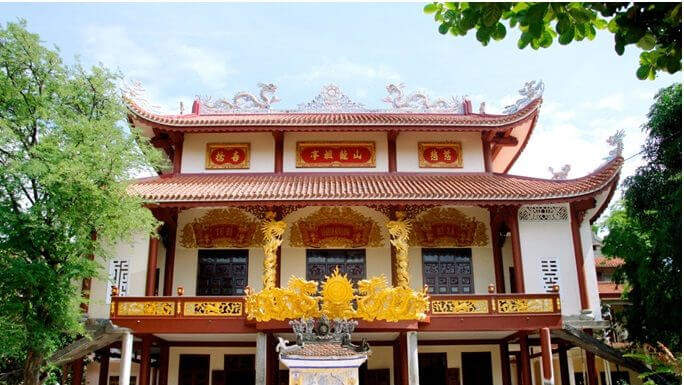
The pagoda was founded by Zen Master Buu Quang, a disciple of Zen Master Minh Hai-Phap Bao, at the end of the 17th century, with the name Giang Long Zen House, located in Tuy Vien district, Tuy Ninh district, Binh Dinh town. In 1744, the pagoda was moved to its present location by Zen Master Thanh Thien and renamed Son Long Pagoda. The current pagoda was restored in 1954. Son Long Pagoda has ancient, rustic, and modest architecture. However, it is these points and the years of historical ups and downs that have brought antiquity, nostalgia, and mystery to the pagoda, attracting visitors from all over to visit. If you have the opportunity to return to Binh Dinh, take the time to visit this temple!
- Address: Nhon Binh commune, Quy Nhon city, Binh Dinh
Long Khanh Pagoda
Long Khanh Pagoda is more than 300 years old, located at 141 Tran Cao Van Street, Le Loi Ward, Quy Nhon City, Binh Dinh Province. Through the events, ups and downs of history, the pagoda no longer exists. inherent architecture. But it still exudes solemnity and respect in the heart of the bustling and bustling Quy Nhon city center. According to historical records, Long Khanh Pagoda has existed since 1715 (At Mui). Up to now, it has been dated over 300 years. It is known that this is a temple built by a Zen master named Duc Son. At that time, the temple was built with the purpose of serving the Chinese community living in this place. The temple was built by the Chinese and we can see a bit of their architectural style in it. Looking from above, you can see that the pagoda is designed in the shape of the word “Khau”. Divided into 2 main areas: Upper Palace and Rear Palace, the second is 2 rows of East and West rooms reserved for monks, nuns, and Buddhists staying at the temple. At the back hall, there is a bronze statue of the Buddha, 1.5 meters high, weighing more than 1,200 kg. Notably, when passing through the three-entrance gate, you will see a 17 m-high Amitabha statue standing on a lotus throne made of green stone placed there.
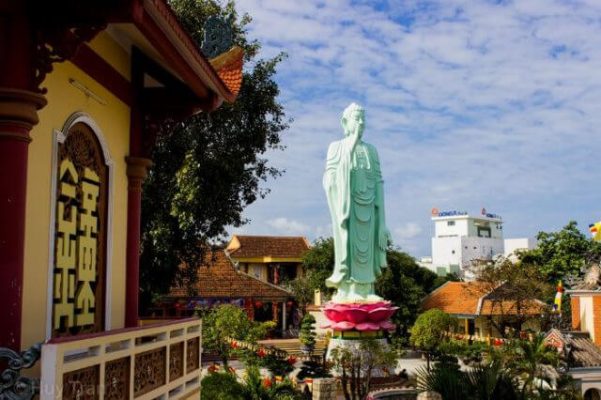
Existing for more than 300 years, and experiencing many events and ups and downs of history, the pagoda had to be restored quite a bit under the reigns of Zen Masters Tich, Thien Thanh, Chinh Nguyen, and Chanh Nhon. The largest restoration was in 1956 and it took 6 years to complete (i.e. 1972). Basically, the temple’s architecture has changed quite a lot compared to the original design. Therefore, the architectural value of the pagoda is not highly appreciated, but in terms of historical nature, the pagoda still retains the bell cast in the 4th year of Gia Long, i.e. 1805. Inscriptions engraved on the bell It is said that Long Khanh Pagoda was formerly located in Vinh Khanh village, Quy Ninh district, and was founded by a Zen master with the Dharma name Tich Tho, whose real name is Nguyen Trinh Tuong. The fact that Zen Master Tich Tho (Nguyen Trinh Tuong) built the bell on the bell has caused confusion for a researcher, who believes that Zen Master Tich Tho was the one who built this place. Up to now, every summer, Long Khanh Pagoda often organizes retreats for thousands of young people, thereby helping young people have meaningful experiences in the summer and be more calm in life. bustling life.
- Address: 141 Tran Cao Van, Tran Hung Dao, Quy Nhon, Binh Dinh
Minh Tinh Pagoda
The pagoda is located at 35 Ham Nghi Street, Ngo May Ward, Quy Nhon City, Binh Dinh Province. Minh Tinh Pagoda has an area of about 1 hectare. The pagoda was founded by Venerable Thich Hue Phap in 1917. The Buddha hall is solemnly and splendidly decorated. More than 700 small Buddha statues are decorated on the walls and columns on the floors of the main hall. The Buddha hall is solemnly decorated. The statue of Shakyamuni Buddha meditating is placed in front of the main hall and in the Buddha hall. In front of the pagoda, there is a three-entrance gate built of stone, three arched doors, and a roof made of cement and imitation tiles. The middle door is nearly 4m high, the two sides are lower, and overall quite massive and sturdy. Above the middle door is an ancient castle, embossed with rows of Phan Van and a statue of Shakyamuni Buddha attaining enlightenment. Under the arch is the pagoda sign: Sac Tu Minh Tinh Tu (Minh Tinh pagoda was given the Sac Tu sign by the king). Inside the alley, in the middle of the yard, there is a statue of Shakyamuni Buddha entering meditation at the Dragon Palace. After the monument comes the main hall. The main hall is a horizontal house, facing the East, built with bricks and tiled, 12m long, 8m wide, 96m2 in area, 1m high foundation, 8m high from foundation to roof, match-stacked roof, collared floor, and statue on the roof. Two dragons flank the letter A. In the pagoda, there is also the newly restored To Hue Phap tower.
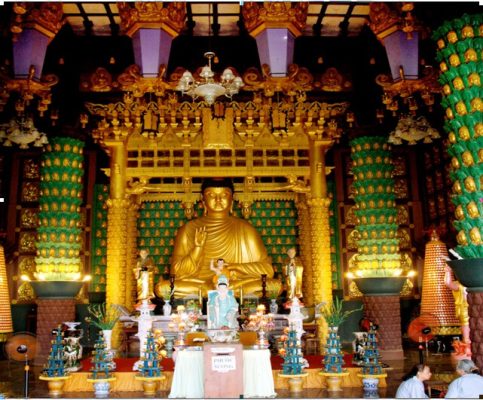
This place is not only for Buddhists to worship, but also a place to receive and save them, training many famous monks, specifically Venerable Thich Khanh Anh, who was educated and brought to the South by Venerable Chon Phuoc. In charge of the course at the Luong Xuyen Buddhist School in 1927 and many other Buddhist courses. Venerable Khanh Anh is famous as a profound Dharma Master and is revered by Southern Buddhism as the Dharma Master. Along with courses taught directly by Venerable Chon Phuoc such as Venerable Binh Chanh, the abbot of Son Long Pagoda – Quy Nhon, Venerable Huyen Quang, Venerable Huyen An, Venerable Thien Hoa, Venerable Thien Hoa and many other classes. Monastics who have the ability to study Buddhism have contributed to the development of Buddhism in the country in general and Buddhism in Binh Dinh province in particular. Every year on major holidays, monks and Buddhists visit hospitals such as Provincial General Hospital, Phong Quy Hoa Hospital, and Psychiatric Hospital, where children with disabilities from Agent Orange and AIDS organize the Eight Precepts retreats for lay Buddhists.
- Address: 35 Hàm Nghi, Ngo May, Quy Nhon City, Binh Dinh
- Phone: 0909 816 875
Nhan Son Pagoda
From Binh Dinh, take the train to Van Son station. Looking to the west, you see a gravel mountain with three rounded peaks, the color of ripe bricks, at the foot of a dense green mango cluster that highlights the red gravel and gray soil color. around. That is Long Cot Mountain, formerly a criminal record for Do Ban citadel, now a screen protecting Nhan Son pagoda nestled under the cool shade of mango trees. The mountain is located in Nhan Thap village, so it is also often called Nhan Thap mountain, and the pagoda is located at the foot of the mountain so it is called Nhan Son pagoda. The name Nhan Son was only given later, previously called Thach Cong Tu, and traditionally called Ong Da Pagoda, because in the pagoda there are two very large stone statues. These two statues stand facing each other. Each statue is three meters high and so large that two adults can hug it. He wears a big robe, a feathered hat, and a weapon in his hand (a statue holding a spear, a statue holding a sword), his face is fierce, and he is so weak that he does not dare to stand close to him. It is said that it is the statue of Huynh Tan Cong and Ly Xuan Dien of the Tran Dynasty.
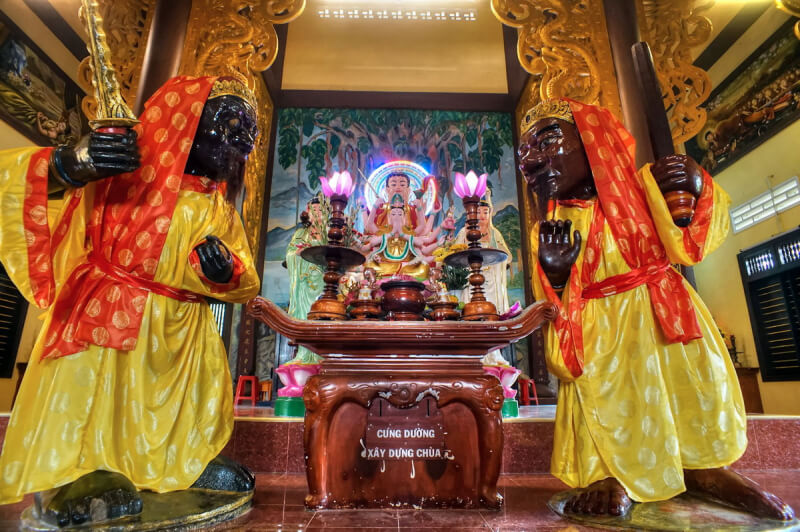
In 2006, the Department of Culture and Information of Binh Dinh province had a plan to renovate this pagoda both to protect two precious ancient Dharma Protector statues of ancient Champa art and to allow local people to continue their traditions. his religious activities. Two statues carved from adjacent blocks of stone, each nearly 3 meters high and weighing a ton, are placed in the main hall of Nhan Son Pagoda. In 1977, an archaeological team from Hanoi determined that these two stone statues date back to the 13th century (more than 700 years ago) and that the temple was restored more than 400 years ago. These are two statues of Dvarapala (Mon Than) the meaning protector of the Dharma, standing 2.3 meters symmetrically, very lively. The sculpture art is typical of Champa sculpture art in the 12th and 13th centuries. Two stone statues painted black and red represent the good man and the evil man in Vietnamese beliefs. If you have the opportunity to come to Binh Dinh, you should not miss a visit and sightseeing at Nhan Son Pagoda, so that you can find a peaceful place, dispel all the fatigue and worries of life, and discover the beauty of culture and traditions here.
- Address: Nhan Thap Nam village, Nhon Hau commune, An Nhon town, Binh Dinh
- Phone: 0914 742 599
Related Article: Top 5 Best Banh Cuon Shops in Binh Dinh For You
If you have the opportunity to come to Binh Dinh, you should not miss a tour and sightseeing of the temples here. That helps us find a peaceful place, dispel all the fatigue and worries of life, and discover the beauty of culture and traditions here. Vietnam Reviewer hopes that all of you will have a nice trip here. If you have any feedback or need help, please send an email to vietnamreviewer.contact@gmail.com!
Noted: All information and pictures are collected!

